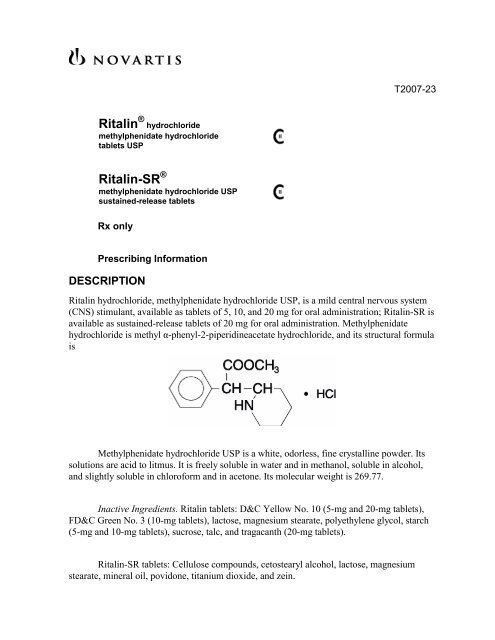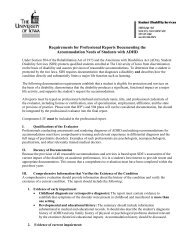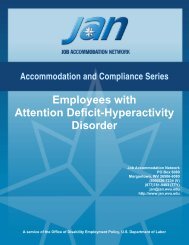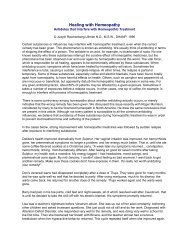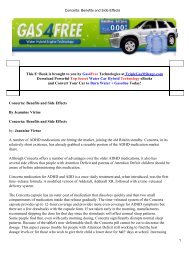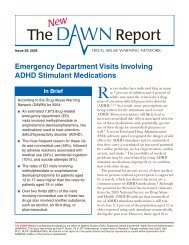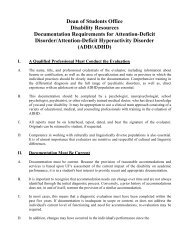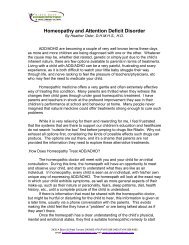Ritalin® Ritalin-SR® - ADHD Info Centre
Ritalin® Ritalin-SR® - ADHD Info Centre
Ritalin® Ritalin-SR® - ADHD Info Centre
Create successful ePaper yourself
Turn your PDF publications into a flip-book with our unique Google optimized e-Paper software.
T2007-23<br />
<strong>Ritalin</strong> ® hydrochloride<br />
methylphenidate hydrochloride<br />
tablets USP<br />
<strong>Ritalin</strong>-SR ®<br />
methylphenidate hydrochloride USP<br />
sustained-release tablets<br />
Rx only<br />
Prescribing <strong>Info</strong>rmation<br />
DESCRIPTION<br />
<strong>Ritalin</strong> hydrochloride, methylphenidate hydrochloride USP, is a mild central nervous system<br />
(CNS) stimulant, available as tablets of 5, 10, and 20 mg for oral administration; <strong>Ritalin</strong>-SR is<br />
available as sustained-release tablets of 20 mg for oral administration. Methylphenidate<br />
hydrochloride is methyl α-phenyl-2-piperidineacetate hydrochloride, and its structural formula<br />
is<br />
Methylphenidate hydrochloride USP is a white, odorless, fine crystalline powder. Its<br />
solutions are acid to litmus. It is freely soluble in water and in methanol, soluble in alcohol,<br />
and slightly soluble in chloroform and in acetone. Its molecular weight is 269.77.<br />
Inactive Ingredients. <strong>Ritalin</strong> tablets: D&C Yellow No. 10 (5-mg and 20-mg tablets),<br />
FD&C Green No. 3 (10-mg tablets), lactose, magnesium stearate, polyethylene glycol, starch<br />
(5-mg and 10-mg tablets), sucrose, talc, and tragacanth (20-mg tablets).<br />
<strong>Ritalin</strong>-SR tablets: Cellulose compounds, cetostearyl alcohol, lactose, magnesium<br />
stearate, mineral oil, povidone, titanium dioxide, and zein.
Page 2<br />
CLINICAL PHARMACOLOGY<br />
<strong>Ritalin</strong> is a mild central nervous system stimulant.<br />
The mode of action in man is not completely understood, but <strong>Ritalin</strong> presumably<br />
activates the brain stem arousal system and cortex to produce its stimulant effect.<br />
There is neither specific evidence which clearly establishes the mechanism whereby<br />
<strong>Ritalin</strong> produces its mental and behavioral effects in children, nor conclusive evidence<br />
regarding how these effects relate to the condition of the central nervous system.<br />
<strong>Ritalin</strong> in the SR tablets is more slowly but as extensively absorbed as in the regular<br />
tablets. Relative bioavailability of the SR tablet compared to the <strong>Ritalin</strong> tablet, measured by<br />
the urinary excretion of <strong>Ritalin</strong> major metabolite (α-phenyl-2-piperidine acetic acid) was<br />
105% (49%-168%) in children and 101% (85%-152%) in adults. The time to peak rate in<br />
children was 4.7 hours (1.3-8.2 hours) for the SR tablets and 1.9 hours (0.3-4.4 hours) for the<br />
tablets. An average of 67% of SR tablet dose was excreted in children as compared to 86% in<br />
adults.<br />
In a clinical study involving adult subjects who received SR tablets, plasma<br />
concentrations of <strong>Ritalin</strong>’s major metabolite appeared to be greater in females than in males.<br />
No gender differences were observed for <strong>Ritalin</strong> plasma concentration in the same subjects.<br />
INDICATIONS<br />
Attention Deficit Disorders, Narcolepsy<br />
Attention Deficit Disorders (previously known as Minimal Brain Dysfunction in Children).<br />
Other terms being used to describe the behavioral syndrome below include: Hyperkinetic<br />
Child Syndrome, Minimal Brain Damage, Minimal Cerebral Dysfunction, Minor Cerebral<br />
Dysfunction.<br />
<strong>Ritalin</strong> is indicated as an integral part of a total treatment program which typically<br />
includes other remedial measures (psychological, educational, social) for a stabilizing effect in<br />
children with a behavioral syndrome characterized by the following group of developmentally<br />
inappropriate symptoms: moderate-to-severe distractibility, short attention span, hyperactivity,<br />
emotional lability, and impulsivity. The diagnosis of this syndrome should not be made with<br />
finality when these symptoms are only of comparatively recent origin. Nonlocalizing (soft)
Page 3<br />
neurological signs, learning disability, and abnormal EEG may or may not be present, and a<br />
diagnosis of central nervous system dysfunction may or may not be warranted.<br />
Special Diagnostic Considerations<br />
Specific etiology of this syndrome is unknown, and there is no single diagnostic test.<br />
Adequate diagnosis requires the use not only of medical but of special psychological,<br />
educational, and social resources.<br />
Characteristics commonly reported include: chronic history of short attention span,<br />
distractibility, emotional lability, impulsivity, and moderate-to-severe hyperactivity; minor<br />
neurological signs and abnormal EEG. Learning may or may not be impaired. The diagnosis<br />
must be based upon a complete history and evaluation of the child and not solely on the<br />
presence of one or more of these characteristics.<br />
Drug treatment is not indicated for all children with this syndrome. Stimulants are not<br />
intended for use in the child who exhibits symptoms secondary to environmental factors<br />
and/or primary psychiatric disorders, including psychosis. Appropriate educational placement<br />
is essential and psychosocial intervention is generally necessary. When remedial measures<br />
alone are insufficient, the decision to prescribe stimulant medication will depend upon the<br />
physician’s assessment of the chronicity and severity of the child’s symptoms.<br />
CONTRAINDICATIONS<br />
Marked anxiety, tension, and agitation are contraindications to <strong>Ritalin</strong>, since the drug may<br />
aggravate these symptoms. <strong>Ritalin</strong> is contraindicated also in patients known to be<br />
hypersensitive to the drug, in patients with glaucoma, and in patients with motor tics or with a<br />
family history or diagnosis of Tourette’s syndrome.<br />
<strong>Ritalin</strong> is contraindicated during treatment with monoamine oxidase inhibitors, and<br />
also within a minimum of 14 days following discontinuation of a monoamine oxidase<br />
inhibitor (hypertensive crises may result).
Page 4<br />
WARNINGS<br />
Serious Cardiovascular Events<br />
Sudden Death and Pre-Existing Structural Cardiac Abnormalities or Other<br />
Serious Heart Problems<br />
Children and Adolescents<br />
Sudden death has been reported in association with CNS stimulant treatment at usual doses in<br />
children and adolescents with structural cardiac abnormalities or other serious heart problems.<br />
Although some serious heart problems alone carry an increased risk of sudden death, stimulant<br />
products generally should not be used in children or adolescents with known serious structural<br />
cardiac abnormalities, cardiomyopathy, serious heart rhythm abnormalities, or other serious<br />
cardiac problems that may place them at increased vulnerability to the sympathomimetic<br />
effects of a stimulant drug.<br />
Adults<br />
Sudden death, stroke, and myocardial infarction have been reported in adults taking stimulant<br />
drugs at usual doses for <strong>ADHD</strong>. Although the role of stimulants in these adult cases is also<br />
unknown, adults have a greater likelihood than children of having serious structural cardiac<br />
abnormalities, cardiomyopathy, serious heart rhythm abnormalities, coronary artery disease, or<br />
other serious cardiac problems. Adults with such abnormalities should also generally not be<br />
treated with stimulant drugs.<br />
Hypertension and Other Cardiovascular Conditions<br />
Stimulant medications cause a modest increase in average blood pressure (about 2-4 mmHg)<br />
and average heart rate (about 3-6 bpm), and individuals may have larger increases. While the<br />
mean changes alone would not be expected to have short-term consequences, all patients<br />
should be monitored for larger changes in heart rate and blood pressure. Caution is indicated<br />
in treating patients whose underlying medical conditions might be compromised by increases<br />
in blood pressure or heart rate, e.g., those with pre-existing hypertension, heart failure, recent<br />
myocardial infarction, or ventricular arrhythmia.<br />
Assessing Cardiovascular Status in Patients being Treated with Stimulant<br />
Medications<br />
Children, adolescents, or adults who are being considered for treatment with stimulant<br />
medications should have a careful history (including assessment for a family history of sudden<br />
death or ventricular arrhythmia) and physical exam to assess for the presence of cardiac<br />
disease, and should receive further cardiac evaluation if findings suggest such disease (e.g.,<br />
electrocardiogram and echocardiogram). Patients who develop symptoms such as exertional<br />
chest pain, unexplained syncope, or other symptoms suggestive of cardiac disease during<br />
stimulant treatment should undergo a prompt cardiac evaluation.
Page 5<br />
Psychiatric Adverse Events<br />
Pre-Existing Psychosis<br />
Administration of stimulants may exacerbate symptoms of behavior disturbance and thought<br />
disorder in patients with a pre-existing psychotic disorder.<br />
Bipolar Illness<br />
Particular care should be taken in using stimulants to treat <strong>ADHD</strong> in patients with comorbid<br />
bipolar disorder because of concern for possible induction of a mixed/ manic episode in such<br />
patients. Prior to initiating treatment with a stimulant, patients with comorbid depressive<br />
symptoms should be adequately screened to determine if they are at risk for bipolar disorder;<br />
such screening should include a detailed psychiatric history, including a family history of<br />
suicide, bipolar disorder, and depression.<br />
Emergence of New Psychotic or Manic Symptoms<br />
Treatment emergent psychotic or manic symptoms, e. g., hallucinations, delusional thinking,<br />
or mania in children and adolescents without a prior history of psychotic illness or mania can<br />
be caused by stimulants at usual doses. If such symptoms occur, consideration should be given<br />
to a possible causal role of the stimulant, and discontinuation of treatment may be appropriate.<br />
In a pooled analysis of multiple short-term, placebo-controlled studies, such symptoms<br />
occurred in about 0.1% (4 patients with events out of 3,482 exposed to methylphenidate or<br />
amphetamine for several weeks at usual doses) of stimulant-treated patients compared to 0 in<br />
placebo-treated patients.<br />
Aggression<br />
Aggressive behavior or hostility is often observed in children and adolescents with <strong>ADHD</strong>,<br />
and has been reported in clinical trials and the postmarketing experience of some medications<br />
indicated for the treatment of <strong>ADHD</strong>. Although there is no systematic evidence that stimulants<br />
cause aggressive behavior or hostility, patients beginning treatment for <strong>ADHD</strong> should be<br />
monitored for the appearance of or worsening of aggressive behavior or hostility.<br />
Long-Term Suppression of Growth<br />
Careful follow-up of weight and height in children ages 7 to 10 years who were randomized to<br />
either methylphenidate or non-medication treatment groups over 14 months, as well as in<br />
naturalistic subgroups of newly methylphenidate-treated and non-medication treated children<br />
over 36 months (to the ages of 10 to 13 years), suggests that consistently medicated children<br />
(i.e., treatment for 7 days per week throughout the year) have a temporary slowing in growth<br />
rate (on average, a total of about 2 cm less growth in height and 2.7 kg less growth in weight<br />
over 3 years), without evidence of growth rebound during this period of development.<br />
Published data are inadequate to determine whether chronic use of amphetamines may cause a<br />
similar suppression of growth, however, it is anticipated that they likely have this effect as<br />
well. Therefore, growth should be monitored during treatment with stimulants, and patients<br />
who are not growing or gaining height or weight as expected may need to have their treatment<br />
interrupted.
Page 6<br />
Seizures<br />
There is some clinical evidence that stimulants may lower the convulsive threshold in patients<br />
with prior history of seizures, in patients with prior EEG abnormalities in absence of seizures,<br />
and, very rarely, in patients without a history of seizures and no prior EEG evidence of<br />
seizures. In the presence of seizures, the drug should be discontinued.<br />
Visual Disturbance<br />
Difficulties with accommodation and blurring of vision have been reported with stimulant<br />
treatment.<br />
Use in Children Under Six Years of Age<br />
<strong>Ritalin</strong> should not be used in children under 6 years, since safety and efficacy in this age group<br />
have not been established.<br />
Drug Dependence<br />
<strong>Ritalin</strong> should be given cautiously to patients with a history of drug dependence or alcoholism.<br />
Chronic abusive use can lead to marked tolerance and psychological dependence with varying<br />
degrees of abnormal behavior. Frank psychotic episodes can occur, especially with parenteral<br />
abuse. Careful supervision is required during withdrawal from abusive use, since severe<br />
depression may occur. Withdrawal following chronic therapeutic use may unmask symptoms<br />
of the underlying disorder that may require follow-up.<br />
PRECAUTIONS<br />
Patients with an element of agitation may react adversely; discontinue therapy if necessary.<br />
Periodic CBC, differential, and platelet counts are advised during prolonged therapy.<br />
Drug treatment is not indicated in all cases of this behavioral syndrome and should be<br />
considered only in light of the complete history and evaluation of the child. The decision to<br />
prescribe <strong>Ritalin</strong> should depend on the physician’s assessment of the chronicity and severity of<br />
the child’s symptoms and their appropriateness for his/her age. Prescription should not depend<br />
solely on the presence of one or more of the behavioral characteristics.<br />
When these symptoms are associated with acute stress reactions, treatment with <strong>Ritalin</strong><br />
is usually not indicated.<br />
<strong>Info</strong>rmation for Patients<br />
Prescribers or other health professionals should inform patients, their families, and their<br />
caregivers about the benefits and risks associated with treatment with methylphenidate and
Page 7<br />
should counsel them in its appropriate use. A patient Medication Guide is available for <strong>Ritalin</strong><br />
and <strong>Ritalin</strong>-SR. The prescriber or health professional should instruct patients, their families,<br />
and their caregivers to read the Medication Guide and should assist them in understanding its<br />
contents. Patients should be given the opportunity to discuss the contents of the Medication<br />
Guide and to obtain answers to any questions they may have. The complete text of the<br />
Medication Guide is reprinted at the end of this document.<br />
Drug Interactions<br />
<strong>Ritalin</strong> should not be used in patients being treated (currently or within the proceeding two<br />
weeks) with MAO Inhibitors (see CONTRAINDICATIONS, Monoamine Oxidase Inhibitors).<br />
Because of possible effects on blood pressure, <strong>Ritalin</strong> should be used cautiously with pressor<br />
agents.<br />
Methylphenidate may decrease the effectiveness of drugs used to treat hypertension.<br />
Methylphenidate is metabolized primarily to ritalinic acid by de-esterification and not through<br />
oxidative pathways.<br />
Human pharmacologic studies have shown that racemic methylphenidate may inhibit the<br />
metabolism of coumarin anticoagulants, anticonvulsants (e.g., phenobarbital, phenytoin,<br />
primidone), and tricyclic drugs (e.g., imipramine, clomipramine, desipramine). Downward<br />
dose adjustments of these drugs may be required when given concomitantly with<br />
methylphenidate. It may be necessary to adjust the dosage and monitor plasma drug<br />
concentration (or, in case of coumarin, coagulation times), when initiating or discontinuing<br />
methylphenidate.<br />
Serious adverse events have been reported in concomitant use with clonidine, although no<br />
causality for the combination has been established. The safety of using methylphenidate in<br />
combination with clonidine or other centrally acting alpha-2-agonists has not been<br />
systematically evaluated.<br />
Carcinogenesis/Mutagenesis/Impairment of Fertility<br />
In a lifetime carcinogenicity study carried out in B6C3F1 mice, methylphenidate caused an<br />
increase in hepatocellular adenomas and, in males only, an increase in hepatoblastomas, at a<br />
daily dose of approximately 60 mg/kg/day. This dose is approximately 30 times and 4 times<br />
the maximum recommended human dose on a mg/kg and mg/m 2 basis, respectively.<br />
Hepatoblastoma is a relatively rare rodent malignant tumor type. There was no increase in<br />
total malignant hepatic tumors. The mouse strain used is sensitive to the development of<br />
hepatic tumors, and the significance of these results to humans is unknown.<br />
Methylphenidate did not cause any increases in tumors in a lifetime carcinogenicity<br />
study carried out in F344 rats; the highest dose used was approximately 45 mg/kg/day, which<br />
is approximately 22 times and 5 times the maximum recommended human dose on a mg/kg<br />
and mg/m 2 basis, respectively.
Page 8<br />
In a 24-week carcinogenicity study in the transgenic mouse strain p53+/-, which is<br />
sensitive to genotoxic carcinogens, there was no evidence of carcinogenicity. Male and female<br />
mice were fed diets containing the same concentration of methylphenidate as in the lifetime<br />
carcinogenicity study; the high-dose groups were exposed to 60-74 mg/kg/day of<br />
methylphenidate.<br />
Methylphenidate was not mutagenic in the in vitro Ames reverse mutation assay or in<br />
the in vitro mouse lymphoma cell forward mutation assay. Sister chromatid exchanges and<br />
chromosome aberrations were increased, indicative of a weak clastogenic response, in an in<br />
vitro assay in cultured Chinese Hamster Ovary (CHO) cells. Methylphenidate was negative in<br />
vivo in males and females in the mouse bone marrow micronucleus assay.<br />
Methlyphenidate did not impair fertility in male or female mice that were fed diets<br />
containing the drug in an 18-week Continuous Breeding study. The study was conducted at<br />
doses up to 160 mg/kg/day, approximately 80-fold and 8-fold the highest recommended dose<br />
on a mg/kg and mg/m 2 basis, respectively.<br />
PREGNANCY<br />
Pregnancy Category C<br />
In studies conducted in rats and rabbits, methylphenidate was administered orally at doses of<br />
up to 75 and 200 mg/kg/day, respectively, during the period of organogenesis. Teratogenic<br />
effects (increased incidence of fetal spina bifida) were observed in rabbits at the highest dose,<br />
which is approximately 40 times the maximum recommended human dose (MRHD) on a<br />
mg/m 2 basis. The no effect level for embryo-fetal development in rabbits was 60 mg/kg/day<br />
(11 times the MRHD on a mg/m 2 basis). There was no evidence of specific teratogenic activity<br />
in rats, although increased incidences of fetal skeletal variations were seen at the highest dose<br />
level (7 times the MRHD on a mg/m 2 basis), which was also maternally toxic. The no effect<br />
level for embryo-fetal development in rats was 25 mg/kg/day (2 times the MRHD on a mg/m 2<br />
basis). When methylphenidate was administered to rats throughout pregnancy and lactation at<br />
doses of up to 45 mg/kg/day, offspring body weight gain was decreased at the highest dose (4<br />
times the MRHD on a mg/m 2 basis), but no other effects on postnatal development were<br />
observed. The no effect level for pre- and postnatal development in rats was 15 mg/kg/day<br />
(equal to the MRHD on a mg/m 2 basis).<br />
Adequate and well-controlled studies in pregnant women have not been conducted.<br />
<strong>Ritalin</strong> should be used during pregnancy only if the potential benefit justifies the potential risk<br />
to the fetus.
Page 9<br />
Nursing Mothers<br />
It is not known whether methylphenidate is excreted in human milk. Because many drugs are<br />
excreted in human milk, caution should be exercised if <strong>Ritalin</strong> is administered to a nursing<br />
woman.<br />
Pediatric Use<br />
<strong>Ritalin</strong> should not be used in children under six years of age (see WARNINGS).<br />
In a study conducted in young rats, methylphenidate was administered orally at doses<br />
of up to 100 mg/kg/day for 9 weeks, starting early in the postnatal period (Postnatal Day 7)<br />
and continuing through sexual maturity (Postnatal Week 10). When these animals were tested<br />
as adults (Postnatal Weeks 13-14), decreased spontaneous locomotor activity was observed in<br />
males and females previously treated with 50 mg/kg/day (approximately 6 times the maximum<br />
recommended human dose [MRHD] on a mg/m 2 basis) or greater, and a deficit in the<br />
acquisition of a specific learning task was seen in females exposed to the highest dose (12<br />
times the MRHD on a mg/m 2 basis). The no effect level for juvenile neurobehavioral<br />
development in rats was 5 mg/kg/day (half the MRHD on a mg/m 2 basis). The clinical<br />
significance of the long-term behavioral effects observed in rats is unknown.<br />
ADVERSE REACTIONS<br />
Nervousness and insomnia are the most common adverse reactions but are usually controlled<br />
by reducing dosage and omitting the drug in the afternoon or evening. Other reactions include<br />
hypersensitivity (including skin rash, urticaria, fever, arthralgia, exfoliative dermatitis,<br />
erythema multiforme with histopathological findings of necrotizing vasculitis, and<br />
thrombocytopenic purpura); anorexia; nausea; dizziness; palpitations; headache; dyskinesia;<br />
drowsiness; blood pressure and pulse changes, both up and down; tachycardia; angina; cardiac<br />
arrhythmia; abdominal pain; weight loss during prolonged therapy. There have been rare<br />
reports of Tourette’s syndrome. Toxic psychosis has been reported. Although a definite causal<br />
relationship has not been established, the following have been reported in patients taking this<br />
drug: instances of abnormal liver function, ranging from transaminase elevation to hepatic<br />
coma; isolated cases of cerebral arteritis and/or occlusion; leukopenia and/or anemia; transient<br />
depressed mood; aggressive behavior; a few instances of scalp hair loss. Very rare reports of<br />
neuroleptic malignant syndrome (NMS) have been received, and, in most of these, patients<br />
were concurrently receiving therapies associated with NMS. In a single report, a ten-year-old<br />
boy who had been taking methylphenidate for approximately 18 months experienced an<br />
NMS-like event within 45 minutes of ingesting his first dose of venlafaxine. It is uncertain<br />
whether this case represented a drug-drug interaction, a response to either drug alone, or some<br />
other cause.
Page 10<br />
In children, loss of appetite, abdominal pain, weight loss during prolonged therapy,<br />
insomnia, and tachycardia may occur more frequently; however, any of the other adverse<br />
reactions listed above may also occur.<br />
DOSAGE AND ADMINISTRATION<br />
Dosage should be individualized according to the needs and responses of the patient.<br />
Adults<br />
Tablets: Administer in divided doses 2 or 3 times daily, preferably 30 to 45 minutes before<br />
meals. Average dosage is 20 to 30 mg daily. Some patients may require 40 to 60 mg daily. In<br />
others, 10 to 15 mg daily will be adequate. Patients who are unable to sleep if medication is<br />
taken late in the day should take the last dose before 6 p.m.<br />
SR Tablets: <strong>Ritalin</strong>-SR tablets have a duration of action of approximately 8 hours.<br />
Therefore, <strong>Ritalin</strong>-SR tablets may be used in place of <strong>Ritalin</strong> tablets when the 8-hour dosage<br />
of <strong>Ritalin</strong>-SR corresponds to the titrated 8-hour dosage of <strong>Ritalin</strong>. <strong>Ritalin</strong>-SR tablets must be<br />
swallowed whole and never crushed or chewed.<br />
Children (6 years and over)<br />
<strong>Ritalin</strong> should be initiated in small doses, with gradual weekly increments. Daily dosage above<br />
60 mg is not recommended.<br />
If improvement is not observed after appropriate dosage adjustment over a one-month<br />
period, the drug should be discontinued.<br />
Tablets: Start with 5 mg twice daily (before breakfast and lunch) with gradual<br />
increments of 5 to 10 mg weekly.<br />
SR Tablets: <strong>Ritalin</strong>-SR tablets have a duration of action of approximately 8 hours.<br />
Therefore, <strong>Ritalin</strong>-SR tablets may be used in place of <strong>Ritalin</strong> tablets when the 8-hour dosage<br />
of <strong>Ritalin</strong>-SR corresponds to the titrated 8-hour dosage of <strong>Ritalin</strong>. <strong>Ritalin</strong>-SR tablets must be<br />
swallowed whole and never crushed or chewed.<br />
If paradoxical aggravation of symptoms or other adverse effects occur, reduce dosage,<br />
or, if necessary, discontinue the drug.
Page 11<br />
<strong>Ritalin</strong> should be periodically discontinued to assess the child’s condition.<br />
Improvement may be sustained when the drug is either temporarily or permanently<br />
discontinued.<br />
Drug treatment should not and need not be indefinite and usually may be discontinued<br />
after puberty.<br />
OVERDOSAGE<br />
Signs and symptoms of acute overdosage, resulting principally from overstimulation of the<br />
central nervous system and from excessive sympathomimetic effects, may include the<br />
following: vomiting, agitation, tremors, hyperreflexia, muscle twitching, convulsions (may be<br />
followed by coma), euphoria, confusion, hallucinations, delirium, sweating, flushing,<br />
headache, hyperpyrexia, tachycardia, palpitations, cardiac arrhythmias, hypertension,<br />
mydriasis, and dryness of mucous membranes.<br />
Consult with a Certified Poison Control Center regarding treatment for up-to-date<br />
guidance and advice.<br />
Treatment consists of appropriate supportive measures. The patient must be protected<br />
against self-injury and against external stimuli that would aggravate overstimulation already<br />
present. Gastric contents may be evacuated by gastric lavage. In the presence of severe<br />
intoxication, use a carefully titrated dosage of a short-acting barbiturate before performing<br />
gastric lavage. Other measures to detoxify the gut include administration of activated charcoal<br />
and a cathartic.<br />
Intensive care must be provided to maintain adequate circulation and respiratory<br />
exchange; external cooling procedures may be required for hyperpyrexia.<br />
Efficacy of peritoneal dialysis or extracorporeal hemodialysis for <strong>Ritalin</strong> overdosage<br />
has not been established.<br />
HOW SUPPLIED<br />
Tablets 5 mg - round, yellow (imprinted CIBA 7)<br />
Bottles of 100……………………………………………………………......NDC<br />
0078-0439-05
Page 12<br />
Tablets 10 mg - round, pale green, scored (imprinted CIBA 3)<br />
Bottles of 100……………………………………………………………......NDC<br />
0078-0440-05<br />
Tablets 20 mg - round, pale yellow, scored (imprinted CIBA 34)<br />
Bottles of 100……………………………………………………………......NDC 0078-<br />
0441-05<br />
Store at 25°C (77°F); excursions permitted to 15-30°C (59-86°F) [see USP Controlled<br />
Room Temperature]. Protect from light.<br />
Dispense in tight, light-resistant container (USP).<br />
SR Tablets 20 mg - round, white, coated (imprinted CIBA 16)<br />
Bottles of 100……………………………………………………………...NDC 0078-<br />
0442-05<br />
Note: SR Tablets are color-additive free.<br />
Store at 25°C (77°F); excursions permitted to 15-30°C (59-86°F) [see USP Controlled<br />
Room Temperature]. Protect from moisture.<br />
Dispense in tight, light-resistant container (USP).<br />
REV: APRIL 2007 T2007-23<br />
MEDICATION GUIDE<br />
RITALIN ®<br />
(methylphenidate hydrochloride tablets, USP) CII<br />
Read the Medication Guide that comes with RITALIN ® before you or your child starts taking it and each time you get a refill. There<br />
may be new information. This Medication Guide does not take the place of talking to your doctor about your or your child’s treatment<br />
with RITALIN ® .<br />
What is the most important information I should know about RITALIN ® ?
Page 13<br />
The following have been reported with use of methylphenidate hydrochloride and other stimulant medicines.<br />
1. Heart-related problems:<br />
• sudden death in patients who have heart problems or heart defects<br />
• stroke and heart attack in adults<br />
• increased blood pressure and heart rate<br />
Tell your doctor if you or your child have any heart problems, heart defects, high blood pressure, or a family history of these problems.<br />
Your doctor should check you or your child carefully for heart problems before starting RITALIN ® .<br />
Your doctor should check your or your child’s blood pressure and heart rate regularly during treatment with RITALIN ® .<br />
Call your doctor right away if you or your child has any signs of heart problems such as chest pain, shortness of breath, or<br />
fainting while taking RITALIN ® .<br />
2. Mental (Psychiatric) problems:<br />
All Patients<br />
• new or worse behavior and thought problems<br />
• new or worse bipolar illness<br />
• new or worse aggressive behavior or hostility<br />
Children and Teenagers<br />
• new psychotic symptoms (such as hearing voices, believing things that are not true, are suspicious) or new manic<br />
symptoms<br />
Tell your doctor about any mental problems you or your child have, or about a family history of suicide, bipolar illness, or depression.<br />
Call your doctor right away if you or your child have any new or worsening mental symptoms or problems while taking<br />
RITALIN ® , especially seeing or hearing things that are not real, believing things that are not real, or are suspicious.<br />
What Is RITALIN ® ?<br />
RITALIN ® is a central nervous system stimulant prescription medicine. It is used for the treatment of Attention-Deficit<br />
Hyperactivity Disorder (<strong>ADHD</strong>). RITALIN ® may help increase attention and decrease impulsiveness and hyperactivity in patients<br />
with <strong>ADHD</strong>.<br />
RITALIN ® should be used as a part of a total treatment program for <strong>ADHD</strong> that may include counseling or other therapies.<br />
RITALIN ® is also used in the treatment of a sleep disorder called narcolepsy.<br />
RITALIN ® is a federally controlled substance (CII) because it can be abused or lead to dependence. Keep RITALIN ® in a safe<br />
place to prevent misuse and abuse. Selling or giving away RITALIN ® may harm others, and is against the law.<br />
Tell your doctor if you or your child have (or have a family history of) ever abused or been dependent on alcohol, prescription<br />
medicines or street drugs.
Page 14<br />
Who should not take RITALIN ® ?<br />
RITALIN ® should not be taken if you or your child:<br />
• are very anxious, tense, or agitated<br />
• have an eye problem called glaucoma<br />
• have tics or Tourette’s syndrome, or a family history of Tourette’s syndrome. Tics are hard to control repeated movements or<br />
sounds.<br />
• are taking or have taken within the past 14 days an anti-depression medicine called a monoamine oxidase inhibitor or MAOI.<br />
• are allergic to anything in RITALIN ® . See the end of this Medication Guide for a complete list of ingredients.<br />
RITALIN ® should not be used in children less than 6 years old because it has not been studied in this age group.<br />
RITALIN ® may not be right for you or your child. Before starting RITALIN ® tell your or your child’s doctor about all health<br />
conditions (or a family history of) including:<br />
• heart problems, heart defects, high blood pressure<br />
• mental problems including psychosis, mania, bipolar illness, or depression<br />
• tics or Tourette’s syndrome<br />
• seizures or have had an abnormal brain wave test (EEG)<br />
Tell your doctor if you or your child is pregnant, planning to become pregnant, or breast-feeding.<br />
Can RITALIN ® be taken with other medicines?<br />
Tell your doctor about all of the medicines that you or your child take including prescription and nonprescription medicines,<br />
vitamins, and herbal supplements. RITALIN ® and some medicines may interact with each other and cause serious side effects.<br />
Sometimes the doses of other medicines will need to be adjusted while taking RITALIN ® .<br />
Your doctor will decide whether RITALIN ® can be taken with other medicines.<br />
Especially tell your doctor if you or your child takes:<br />
• anti-depression medicines including MAOIs<br />
• seizure medicines<br />
• blood thinner medicines<br />
• blood pressure medicines<br />
• cold or allergy medicines that contain decongestants<br />
Know the medicines that you or your child takes. Keep a list of your medicines with you to show your doctor and pharmacist.<br />
Do not start any new medicine while taking RITALIN ® without talking to your doctor first.<br />
How should RITALIN ® be taken?<br />
• Take RITALIN ® exactly as prescribed. Your doctor may adjust the dose until it is right for you or your child.<br />
• <strong>Ritalin</strong> is usually taken 2 to 3 times a day.<br />
• Take RITALIN ® 30 to 45 minutes before a meal.
Page 15<br />
• From time to time, your doctor may stop RITALIN ® treatment for a while to check <strong>ADHD</strong> symptoms.<br />
• Your doctor may do regular checks of the blood, heart, and blood pressure while taking RITALIN ® . Children should have their<br />
height and weight checked often while taking RITALIN ® . RITALIN ® treatment may be stopped if a problem is found during<br />
these check-ups.<br />
• If you or your child takes too much RITALIN ® or overdoses, call your doctor or poison control center right away, or get<br />
emergency treatment.<br />
What are possible side effects of RITALIN ® ?<br />
See “What is the most important information I should know about RITALIN ® ?” for information on reported heart and mental<br />
problems.<br />
Other serious side effects include:<br />
• slowing of growth (height and weight) in children<br />
• seizures, mainly in patients with a history of seizures<br />
• eyesight changes or blurred vision<br />
Common side effects include:<br />
• headache • decreased appetite<br />
• stomach ache • nervousness<br />
• trouble sleeping<br />
• nausea<br />
Talk to your doctor if you or your child has side effects that are bothersome or do not go away.<br />
This is not a complete list of possible side effects. Ask your doctor or pharmacist for more information.<br />
How should I store RITALIN ® ?<br />
• Store RITALIN in a safe place at room temperature, 59 to 86° F (15 to 30° C). Protect from light.<br />
• Keep RITALIN ® and all medicines out of the reach of children.<br />
General information about RITALIN ®<br />
Medicines are sometimes prescribed for purposes other than those listed in a Medication Guide. Do not use RITALIN ® for a condition<br />
for which it was not prescribed. Do not give RITALIN ® to other people, even if they have the same condition. It may harm them and it<br />
is against the law.<br />
This Medication Guide summarizes the most important information about RITALIN ® . If you would like more information, talk with<br />
your doctor. You can ask your doctor or pharmacist for information about RITALIN ® that was written for healthcare professionals.<br />
For more information about RITALIN ® call 1-888-669-6682.<br />
What are the ingredients in RITALIN ® ?<br />
Active Ingredient: methylphenidate HCL<br />
Inactive Ingredients: D&C Yellow No.10 (5-mg and 20-mg tablets), FD&C Green No.3 (10-mg tablets), lactose, magnesium<br />
stearate, polyethylene glycol, starch (5-mg and 10-mg tablets), sucrose, talc, and tragacanth (20-mg tablets).
Page 16<br />
This Medication Guide has been approved by the U.S. Food and Drug Administration.<br />
REV: APRIL 2007 T2007-38
Page 17<br />
MEDICATION GUIDE<br />
RITALIN-SR ®<br />
(methylphenidate hydrochloride, USP) sustained-release tablets CII<br />
Read the Medication Guide that comes with RITALIN-SR ® before you or your child starts taking it and each time you get a refill.<br />
There may be new information. This Medication Guide does not take the place of talking to your doctor about your or your child’s<br />
treatment with RITALIN-SR ® .<br />
What is the most important information I should know about RITALIN-SR ® ?<br />
The following have been reported with use of methylphenidate hydrochloride and other stimulant medicines.<br />
1. Heart-related problems:<br />
• sudden death in patients who have heart problems or heart defects<br />
• stroke and heart attack in adults<br />
• increased blood pressure and heart rate<br />
Tell your doctor if you or your child have any heart problems, heart defects, high blood pressure, or a family history of these problems.<br />
Your doctor should check you or your child carefully for heart problems before starting RITALIN-SR ® .<br />
Your doctor should check your or your child’s blood pressure and heart rate regularly during treatment with RITALIN-SR ® .<br />
Call your doctor right away if you or your child has any signs of heart problems such as chest pain, shortness of breath, or<br />
fainting while taking RITALIN-SR ® .<br />
2. Mental (Psychiatric) problems:<br />
All Patients<br />
• new or worse behavior and thought problems<br />
• new or worse bipolar illness<br />
• new or worse aggressive behavior or hostility<br />
Children and Teenagers<br />
• new psychotic symptoms (such as hearing voices, believing things that are not true, are suspicious) or new manic<br />
symptoms<br />
Tell your doctor about any mental problems you or your child have, or about a family history of suicide, bipolar illness, or depression.<br />
Call your doctor right away if you or your child have any new or worsening mental symptoms or problems while taking<br />
RITALIN-SR ® , especially seeing or hearing things that are not real, believing things that are not real, or are suspicious.<br />
What Is RITALIN-SR ® ?<br />
RITALIN-SR ® is a central nervous system stimulant prescription medicine. It is used for the treatment of Attention-Deficit<br />
Hyperactivity Disorder (<strong>ADHD</strong>). RITALIN-SR ® may help increase attention and decrease impulsiveness and hyperactivity in<br />
patients with <strong>ADHD</strong>.
Page 18<br />
RITALIN-SR ® should be used as a part of a total treatment program for <strong>ADHD</strong> that may include counseling or other therapies.<br />
RITALIN-SR ® is also used in the treatment of a sleep disorder called narcolepsy.<br />
RITALIN-SR ® is a federally controlled substance (CII) because it can be abused or lead to dependence. Keep RITALIN-SR ®<br />
in a safe place to prevent misuse and abuse. Selling or giving away RITALIN-SR ® may harm others, and is against the law.<br />
Tell your doctor if you or your child have (or have a family history of) ever abused or been dependent on alcohol, prescription<br />
medicines or street drugs.<br />
Who should not take RITALIN-SR ® ?<br />
RITALIN-SR ® should not be taken if you or your child:<br />
• are very anxious, tense, or agitated<br />
• have an eye problem called glaucoma<br />
• have tics or Tourette’s syndrome, or a family history of Tourette’s syndrome. Tics are hard to control repeated movements or<br />
sounds.<br />
• are taking or have taken within the past 14 days an anti-depression medicine called a monoamine oxidase inhibitor or MAOI.<br />
• are allergic to anything in RITALIN-SR ® . See the end of this Medication Guide for a complete list of ingredients.<br />
RITALIN-SR ® should not be used in children less than 6 years old because it has not been studied in this age group.<br />
RITALIN-SR ® may not be right for you or your child. Before starting RITALIN-SR ® tell your or your child’s doctor about<br />
all health conditions (or a family history of) including:<br />
• heart problems, heart defects, high blood pressure<br />
• mental problems including psychosis, mania, bipolar illness, or depression<br />
• tics or Tourette’s syndrome<br />
• seizures or have had an abnormal brain wave test (EEG)<br />
Tell your doctor if you or your child is pregnant, planning to become pregnant, or breast-feeding.<br />
Can RITALIN-SR ® be taken with other medicines?<br />
Tell your doctor about all of the medicines that you or your child take including prescription and nonprescription medicines,<br />
vitamins, and herbal supplements. RITALIN-SR ® and some medicines may interact with each other and cause serious side effects.<br />
Sometimes the doses of other medicines will need to be adjusted while taking RITALIN-SR ® .<br />
Your doctor will decide whether RITALIN-SR ® can be taken with other medicines.<br />
Especially tell your doctor if you or your child takes:<br />
• anti-depression medicines including MAOIs<br />
• seizure medicines<br />
• blood thinner medicines<br />
• blood pressure medicines<br />
• cold or allergy medicines that contain decongestants
Know the medicines that you or your child takes. Keep a list of your medicines with you to show your doctor and pharmacist.<br />
Page 19<br />
Do not start any new medicine while taking RITALIN-SR ® without talking to your doctor first.<br />
How should RITALIN-SR ® be taken?<br />
• Take RITALIN-SR ® exactly as prescribed. Your doctor may adjust the dose until it is right for you or your child.<br />
• Take RITALIN-SR ® 30 to 45 minutes before a meal. The effect of a dose of RITALIN-SR usually lasts about 8 hours.<br />
• Do not chew or crush RITALIN-SR ® tablets. Swallow RITALIN-SR ® tablets whole with water or other liquids. Tell your<br />
doctor if you or your child cannot swallow RITALIN-SR ® whole. A different medicine may need to be prescribed.<br />
• From time to time, your doctor may stop RITALIN-SR ® treatment for a while to check <strong>ADHD</strong> symptoms.<br />
• Your doctor may do regular checks of the blood, heart, and blood pressure while taking RITALIN-SR ® . Children should have<br />
their height and weight checked often while taking RITALIN-SR ® . RITALIN-SR ® treatment may be stopped if a problem is<br />
found during these check-ups.<br />
• If you or your child takes too much RITALIN-SR ® or overdoses, call your doctor or poison control center right away, or<br />
get emergency treatment.<br />
What are possible side effects of RITALIN-SR ® ?<br />
See “What is the most important information I should know about RITALIN-SR ® ?” for information on reported heart and mental<br />
problems.<br />
Other serious side effects include:<br />
• slowing of growth (height and weight) in children<br />
• seizures, mainly in patients with a history of seizures<br />
• eyesight changes or blurred vision<br />
Common side effects include:<br />
• headache • decreased appetite<br />
• stomach ache • nervousness<br />
• trouble sleeping<br />
• nausea<br />
Talk to your doctor if you or your child has side effects that are bothersome or do not go away.<br />
This is not a complete list of possible side effects. Ask your doctor or pharmacist for more information.<br />
How should I store RITALIN-SR ® ?<br />
• Store RITALIN-SR ® in a safe place at room temperature, 59 to 86° F (15 to 30° C). Protect from moisture.<br />
• Keep RITALIN-SR ® and all medicines out of the reach of children.<br />
General information about RITALIN-SR ®
Medicines are sometimes prescribed for purposes other than those listed in a Medication Guide. Do not use RITALIN-SR ® for a<br />
condition for which it was not prescribed. Do not give RITALIN-SR ® to other people, even if they have the same condition. It may<br />
harm them and it is against the law.<br />
This Medication Guide summarizes the most important information about RITALIN-SR ® . If you would like more information, talk<br />
with your doctor. You can ask your doctor or pharmacist for information about RITALIN-SR ® that was written for healthcare<br />
professionals. For more information about RITALIN-SR call 1-888-669-6682.<br />
Page 20<br />
What are the ingredients in RITALIN-SR ® ?<br />
Active Ingredient: methylphenidate HCL, USP<br />
Inactive Ingredients: cellulose compounds, cetostearyl alcohol, lactose, magnesium stearate, mineral oil, povidone, titanium dioxide,<br />
and zein<br />
This Medication Guide has been approved by the U.S. Food and Drug Administration.<br />
REV: APRIL 2007 T2007-40<br />
REV: APRIL 2007 Printed in U.S.A. T2007-23/T2007-38/T2007-40<br />
Novartis Pharmaceuticals Corporation<br />
East Hanover, New Jersey 07936<br />
© Novartis


